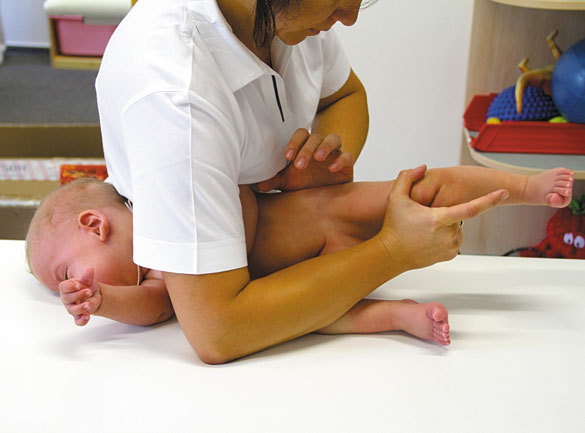Vojta Therapy: Difference between revisions
No edit summary |
No edit summary |
||
| Line 6: | Line 6: | ||
== Description<br> == | == Description<br> == | ||
[[File:Vojta-Therapy.jpeg|right|]] | [[File:Vojta-Therapy.jpeg|right|385 × 233 ]] | ||
'''Vojta-Therapy''' is a dynamic neuromuscular treatment method based on the developmental kinesiology and principles of '''reflex locomotion'''. This method is supposed to treat patients with disorders of central nervous system and musculoskeletal system. It was developed by child neurologist [https://www.vojta.com/en/the-vojta-principle/profvvojta Prof. Vaclav Vojta] in the 20th century. | '''Vojta-Therapy''' is a dynamic neuromuscular treatment method based on the developmental kinesiology and principles of '''reflex locomotion'''. This method is supposed to treat patients with disorders of central nervous system and musculoskeletal system. It was developed by child neurologist [https://www.vojta.com/en/the-vojta-principle/profvvojta Prof. Vaclav Vojta] in the 20th century. | ||
Revision as of 18:19, 14 June 2018
PLEASE DON'T EDIT THIS PAGE. IT IS IN PROCESS OF EDITING.
Description
[edit | edit source]
Vojta-Therapy is a dynamic neuromuscular treatment method based on the developmental kinesiology and principles of reflex locomotion. This method is supposed to treat patients with disorders of central nervous system and musculoskeletal system. It was developed by child neurologist Prof. Vaclav Vojta in the 20th century.
What is a reflex locomotion?[edit | edit source]
Indication[edit | edit source]
Target group[edit | edit source]
The Vojta therapy can be applied to the patients of any age group,however it is extremely effective for young babies of age less than 6 months because most of the developmental changes take place in the early stage of a child’s life. [2]
Indications[edit | edit source]
- Infantile postural asymmetry
- Congenital muscular torticollis (“wry neck”)
- Stroke
- Cerebral palsy
Clinical Presentation[edit | edit source]
Therapeutic effect[edit | edit source]
According to Vojta, reflex locomotion is activated from the three main positions: prone, supine and side lying.
Reflex locomotion is a combination of Reflex Creeping in prone lying position (i.e., lying flat with the chest down and back up)and Reflex Rollinginsupine lying position (i.e., lying flat with the chest up and back down) and side lying positions, as shown in Fig. 1. by putting light pressure on those areas and resistance to thecurrentmovement(e.g.,thetendencytorotatetheheadduring reflex creeping) to cause the patient’s body to perform certain reflexive movement patterns. [2]
The mechanism of intervention[edit | edit source]
By stimulating special reflex points, the physiotherapist can trigger these motor patterns. So the patient’s central nervous system can be activated by giving the correct stimulations.
Evidence[edit | edit source]
This study is the first RCT to show the effects of Vojta therapy and NDT on infantile postural asymmetry. The significant effect achieved through Vojta therapy compared to NDT may be explained by its more intensive muscle activation due to relatively precisely guided movement responses to triggered reflexes.
Resources[edit | edit source]
add appropriate resources here, including text links or content demonstrating the intervention or technique
Additional facts[edit | edit source]
- Vojta therapy is an officially recognized treatment modality for infant asymmetry in Germany and paid by health insurance. [1]







